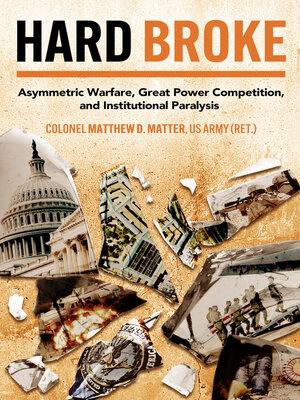Hard Broke
ebook ∣ Asymmetric Warfare, Great Power Competition, and Institutional Paralysis
By M. D. Matter

Sign up to save your library
With an OverDrive account, you can save your favorite libraries for at-a-glance information about availability. Find out more about OverDrive accounts.
Find this title in Libby, the library reading app by OverDrive.



Search for a digital library with this title
Title found at these libraries:
| Library Name | Distance |
|---|---|
| Loading... |
Based on first-hand experience encompassing multiple combat deployments in Iraq, Afghanistan, and the Horn of Africa, this book addresses the threat of asymmetric warfare and the future of combat.
The American way of war is enabled by the concept of massing all available firepower—when done correctly it makes US forces hard to beat. However improvised explosive devices have increasingly enabled a new kind of asymmetric warfare, one that conventional forces continue to struggle to counter. This book offers a “counter-IED playbook,” one based upon the author’s experiences of over 90 months of combat operations, working the problem sets of Fires, Effects, IEDs,
Close Target Reconnaissance, Tracking-Tagging-Locating (TTL), and Information Operations.
This text offers insights into the ways through some of the most complicated problems that have tested the Department of Defense, and the Army—the problems of how a conventional force is organized, manned, equipped, and trained to deal with the problem of IEDs; and how the Army is doctrinally organized to deal with an emerging revolution of military affairs.
The American way of war is enabled by the concept of massing all available firepower—when done correctly it makes US forces hard to beat. However improvised explosive devices have increasingly enabled a new kind of asymmetric warfare, one that conventional forces continue to struggle to counter. This book offers a “counter-IED playbook,” one based upon the author’s experiences of over 90 months of combat operations, working the problem sets of Fires, Effects, IEDs,
Close Target Reconnaissance, Tracking-Tagging-Locating (TTL), and Information Operations.
This text offers insights into the ways through some of the most complicated problems that have tested the Department of Defense, and the Army—the problems of how a conventional force is organized, manned, equipped, and trained to deal with the problem of IEDs; and how the Army is doctrinally organized to deal with an emerging revolution of military affairs.







